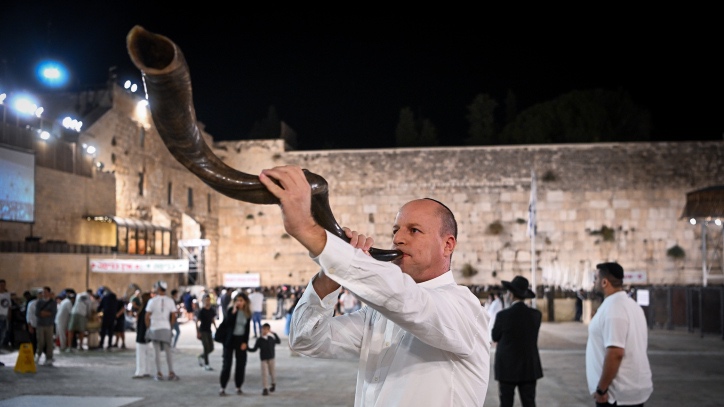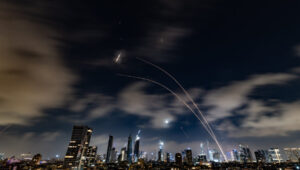The Rosh Hashanah experience in the United States is very different from the Rosh Hasanah experience in Israel. Growing up in the United States in Rockville, Maryland, near Washington, DC, I went to a Reform synagogue, Washington Hebrew Congregation, where we used to go to poetry readings and listen to Hebrew songs accompanied by guitar music every Rosh Hashanah. Every year, we used to tear challah bread and throw it into baby swimming pools, which were displayed on the grass in front of the synagogue. I used to love to hear the blast of the shofar and to eat apples dipped in honey, as well as honey cake.
Because I grew up in a heavily Jewish area, all of the schools shut down for Rosh Hashanah, because a good percentage of both the teachers and the students were Jewish. This was something that people should not take for granted. Later on in college, when I studied in less Jewish areas, the universities did not shut down for Rosh Hashanah and it was always a struggle to catch up with what you missed by taking off for the Jewish High Holidays.
But Rosh Hashanah in Israel is a very different experience. In the United States, you can only feel the holiness of Rosh Hashanah inside of synagogues. Everywhere else, Rosh Hashanah is just another day. But in Israel, everything shuts down for Rosh Hashanah, people walk to synagogue dressed in white, and families gather together both to do BBQs and to have a special seder just for the Rosh Hashanah holiday.
Growing up in America, I never attended such seders. But here in Israel, these Rosh Hashanah Seders are a pivotal part of the holiday. In Iraqi Jewish families in Israel, people eat the head of a lamb, rubiya, leeks, pomegranates, dates, apples with honey, beets, pumpkin and many other types of vegetables. They also eat apple jam in addition to the traditional apple and honey eaten by all Jews. Each of the things that we ate had a special blessing. This was in addition to the round challah bread that is served in all Jewish communities on Rosh Hashanah.
The blessings in the Seder begin with the words yehi ratzon (may it be G-d’s will) and then ask G-d to help us defeat our enemies and bless us for the year to come. The origins of the Seder date back to the Talmud (Horayot 12a), where Abaye discusses various omens and suggests that people should eat these foods at the beginning of each year in order to bring prosperity for the next year. According to cookbook author Gilda Angel (Sephardic Holiday Cooking), “It is told that when the Babylonian scholar Hai Gaon (939-1039) left the synagogue on Rosh Hashanah , his students would bring him a basket filled with different fruits over which he recited various blessings and biblical verses.” The Baghdadi rabbi Hakham Yosef Hayyim (1832-1909) mentions the ceremony in his compilation of Jewish law and practice.
After the Seder is completed, many Iraqi Jewish families eat kebabs, chicken, steak, cooba (selomina and rice with meat stuffed inside), rice, sambosak (Iraqi samosa), umba (Iraqi Mango sauce), various salads, and had baklava, apple cakes and other sweets for dessert. The salads include traditional preserved olives, preserved pickles, preserved peppers and other preserved foods that Iraqi Jews make.
Moroccan Jews also have a similar Seder. They serve seven different vegetables boiled and then baked with cinnamon, sugar and a little margarine. Before tasting each vegetable, they will recite the following blessing:
“May the coming year grow as a gourd in fullness of blessing. In the year to come, if enemies gather against us, mayest Thou guard us as we eat of this gourd with the prayer: Blessed art Thou, Lord our God, Ruler of the Universe, who created the fruit of the earth.”
In the meal, Moroccan Jews will serve a wide variety of salads, as it is their tradition to eat about 20 different salads before each meal. This will be followed by a rich display of meats and a special holiday couscous.
Ashkenazi Jews will typically substitute the head of a fish for the head of the lamb at their Seder. They also eat carrots, apples, honey and other things that bring a blessing for the new year. However, they do not have an elaborate Seder like Sephardic, Mizrahi and Indian Jews do. Their expression of Rosh Hashanah is more similar to what I grew up with in America. Nevertheless, the Ashkenazi Rosh Hashanah experience in Israel is still richer, as one tosses their sins away into the Mediterranean Sea instead of some swimming pool for babies. This is a spiritually rich experience.
The day after the Seder, Israelis usually go to the synagogue to pray and then to some park to have a BBQ, where they eat steak, BBQ chicken, kebabs, spicy hot dogs (Hebrew National Hot Dogs don’t exist in the Mizrahi kitchen as they are too bland), and various other meats together with homemade pita bread and some salads. After this BBQ, Israelis go back to the synagogue to pray, only to repeat the same ritual the next day, as we have two days of Rosh Hashanah. It is very common also for Israelis to take trips on Rosh Hashanah to meet with relatives in other parts of the country. And this is what makes Rosh Hashanah in Israel a unique experience.















